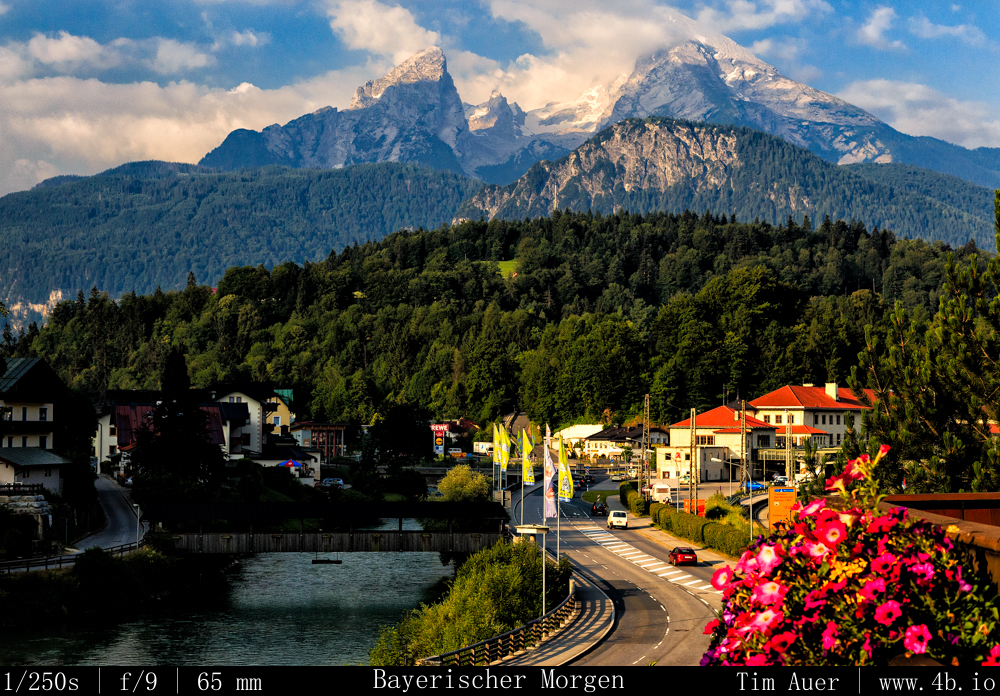Float Plane taking lift in Brooks Lake Alaska.
*Note the Sockeye Salmon jumping in the foreground. *


Tim Auer
Float Plane taking lift in Brooks Lake Alaska.
*Note the Sockeye Salmon jumping in the foreground. *

Near the base of the Alaska Peninsula, a national park stretches from the Bristol Bay lowlands across to the Shelikof Strait. Lightly visited and little known outside Alaska, Katmai is larger than Yellowstone and Yosemite — combined.
– John Grabowska, Katmai, 2013. Alaska Peninsula
Katmai is an extraordinary place and I cannot wait for my next trip there
The Brooks Camp area is teeming with the world’s largest land carnivores, the coastal Brown Bear. Who, despite being so large and powerful, are as laid back and relaxed as any bear I met before. Completely different from those nasty interior grizzlies. The bears here are cool. And while a bear of any size can be dangerous, the bears of Katmai tolerate the close proximity of humans and competing bears like nowhere else. Such an abundance of high calorie food does an effective job to transform this ornery beast into a creature with an amiable disposition….
Attack that human? We Katmai bears don’t care!
I am still trying to best figure out how to organize my posts on Katmai. As you can imagine, many photos were taken, and there is a lot to say about preparations, gear reviews, bear anecdotes, and things to do differently next time. Lets start with the experiences from the first day at Brooks Camp and some general observations made about the bears…and move forward from there…
And so to the Alaska Peninsula we come, seeking the limits of the known world at the ends of the Earth…A cloud-cloaked landscape, the Alaska Peninsula is accessible only by air or water.

The flight from Anchorage to King Salmon took about 90 minutes on PenAir and once in King Salmon, we took a short bus ride to the Naknek River to office of Katmai Air and their dock+float plane. While at the office, we weighed our bags and learned how much over the 50 lbs limit it was. I was 80 lbs over the limit. Camera gear really starts to add up! Due the small size of the planes and their finite lift, the total load must be measured before taking off. If the load is greater than what the plane can carry, gear is jettisoned and ferried in on later planes. Fortunately I did not have this problem, I paid the $0.60/lb overage charge and was able to get all my gear on my flight. The leg to Brooks Camp is a short one, only taking about 20-25 minutes.


After flying over soggy lowlands, lakes, and along the sides of mountains, we softly touched down in Nahnek Lake a little before 13:00. We had arrived to Brooks Camp. God rays shone down on the mountains in the distance as we disembarked on a wooden plank that lead to us shore. Before reaching the shore, we could already see our first bear, swimming at the mouth of the river. My nightmarish fear of not seeing any bears quickly subsided, the trip was off to a good start. After finishing the 10 minute ranger led safety briefing, we lugged our gear to the campground.
This campground can described as an area of tall grass and trees enclosed by a bear resistant electric fence (not “bear proof”) about 20m from the shore of Naknek Lake. The campground is a bargain, especially when compared to the cost of the lodge. Having a National Parks pass gives a 50% discount too. Three nights of camping cost only $18. With camp set up, we set off towards the river in search of bears…..

By September the brown bears of Katmai are big, fat, and round. They are only a few weeks away from hibernation and have already put away the bulk of the calories needed to survive the Alaska winter. The salmon here are Sockeye and this location is most famous for the iconic photos of the bears at Brooks Falls catching pre-spawned Salmon mid-leap. It is possible to get these photos at the peak of the salmon run, which is usually sometime in mid-July. It is during this peak that the highest concentration of bears falls is present at the falls. There have been times when over 70 bears (!!) were counted in the river. The peak is considered the best time to visit Brooks. It is also the most crowded and expensive time to visit. The next next best time to visit is early September, when most of the salmon have already spawned and are patiently waiting to die.

During September bears are more frequently found in at the mouth and at the source of the Brooks River. By this time, the salmon have exhausted almost all of their energy traveling from the ocean to their ancestral spawning grounds. In the process of this journey, the sockeye begin a transformation from a silver colored fish to having the appearance of blood red and distorted sea monster.
One of the interesting aspects of visiting Katmai NP for the first time (and staying multiple days) is that you can visually track your improvement as a wildlife photographer. Within a few hours, you are beginning to recognize the frequently observed bears. First by appearance, whether it is Ted with his hip scar, or Otis of the far pool, with his floppy ear and head scar. After some more time, you begin to differentiate and recognize bears by their fishing techniques and mannerisms. Some snorkel head down scanning the river. Some ambush an unsuspecting salmon by sprinting and pouncing. Some bears exclusively scavenge and others steal. A few bears prefer to sit perfectly still and let the fish come to them, snatching the fish with a quick paw. Otis is known for this, and he would sit perfectly still in the rushing water for minutes. I was even able to take a sharp photo of him in the far pool with a slow shutter speed of 1/20s.

Here is an animation showing Otis devouring a salmon. Notice how he braces the fish on his shin. Click through the image below for the full version of this animation.

All of these observations are important and key to improving your photography. Once you are able to recognize a bear and associate specific behaviors to it, your ability to anticipate action before it happens is improved. You begin to sense when a bear locks its radar on a fish, and can be ready to click the shutter at just the right moment. Let off the shutter after the initial catch to so buffer can be writen to memory, then burst again when the bear shakes water from its head. It was even possible to recognize the differences in behavior between a failed and successful fishing attempt, before the bear brings the fish up.
I still have much to learn before I can call myself a bear behaviorist expert, but it is amazing how careful observation increases your ability to recognize behaviors, and can drastically improve your photography.
Before leaving for Alaska, I studied as much information as I could to prepare myself. I read the bear documentation and eBooks provided by the NPS, studied maps of the Brooks Camp area and viewed the web cameras. All of these resources proved to be helpful. By reading the NPS Katmai Bear eBook, it was easier to recognize which female bears were more skittish about her cubs and how it is possible to age a bear based on the size of their head in proportion to rest of body or how playful they are. Young, or sub-adult, bears may look large, but their bulk may be excess fur. The size of the head is a good way to gauge their age. The head appears bigger in proportion to the rest of their body on subadults. So if you see a bear whose head accounts for approximately 1/3 of the total length, this is a good indicator the bear is young and still growing into its head. The guide also made it easier to react safely to approaching bears and avoid a dangerous situation. Viewing the web camera gave me an early look into bear behavior and introduced me to the weather patterns and lighting conditions that would likely be encountered.
This preliminary knowledge served a couple useful purposes. One benefit was that it helped to psych myself up for the trip. Another benefit was it gave me some ideas for image compositions. I began to formulate the type of images I would work to capture once on-site. By thinking these images out in advance, I was more in control of my gear and ready to switch from say a stop-action configuration to a panning motion.

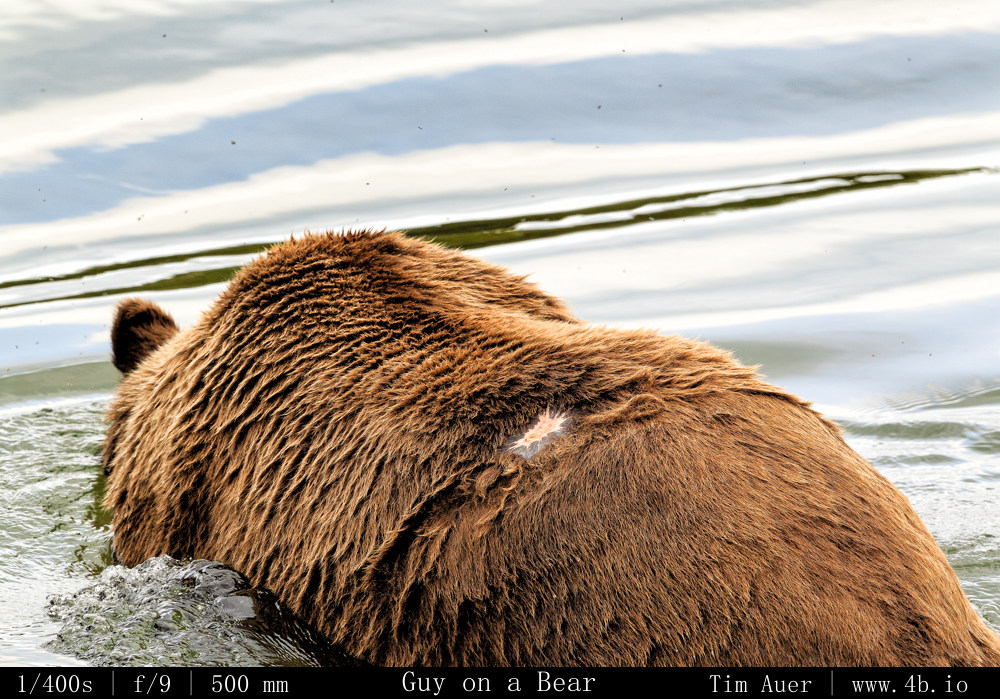







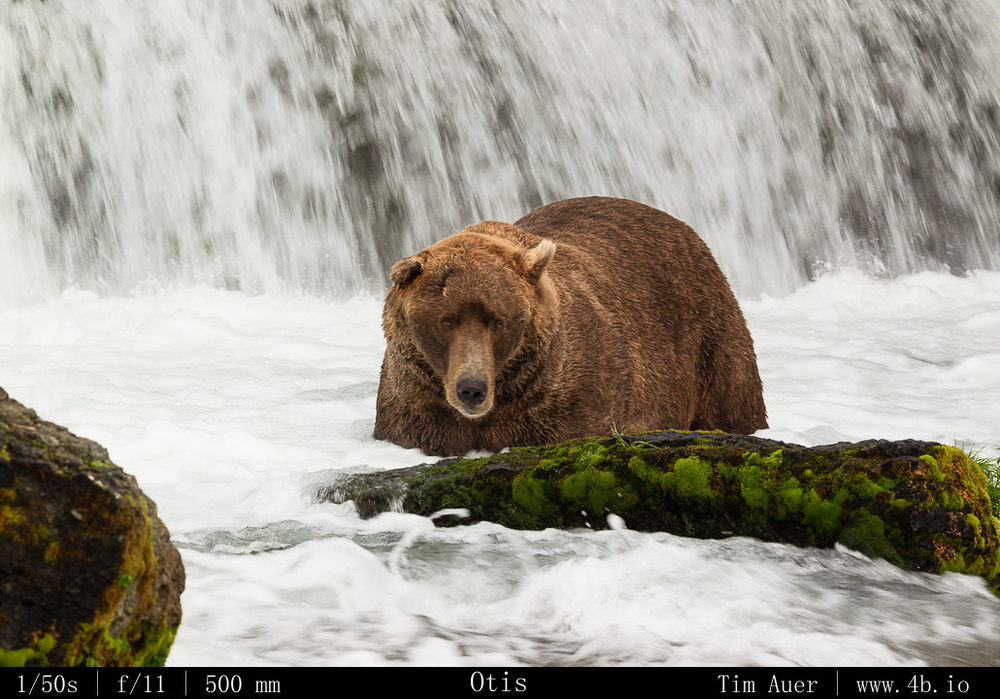



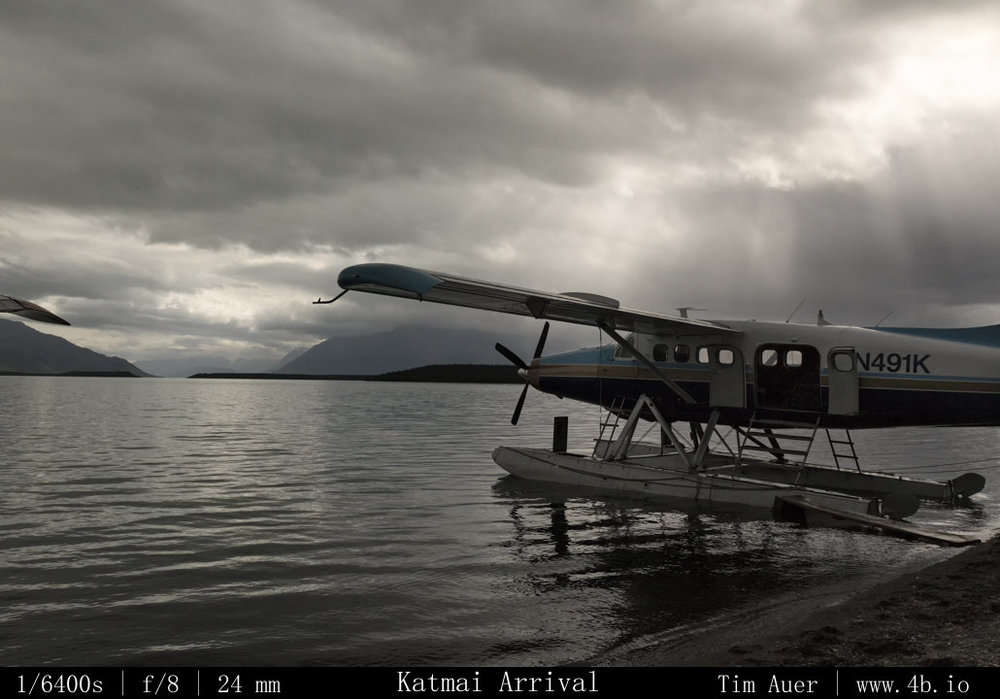
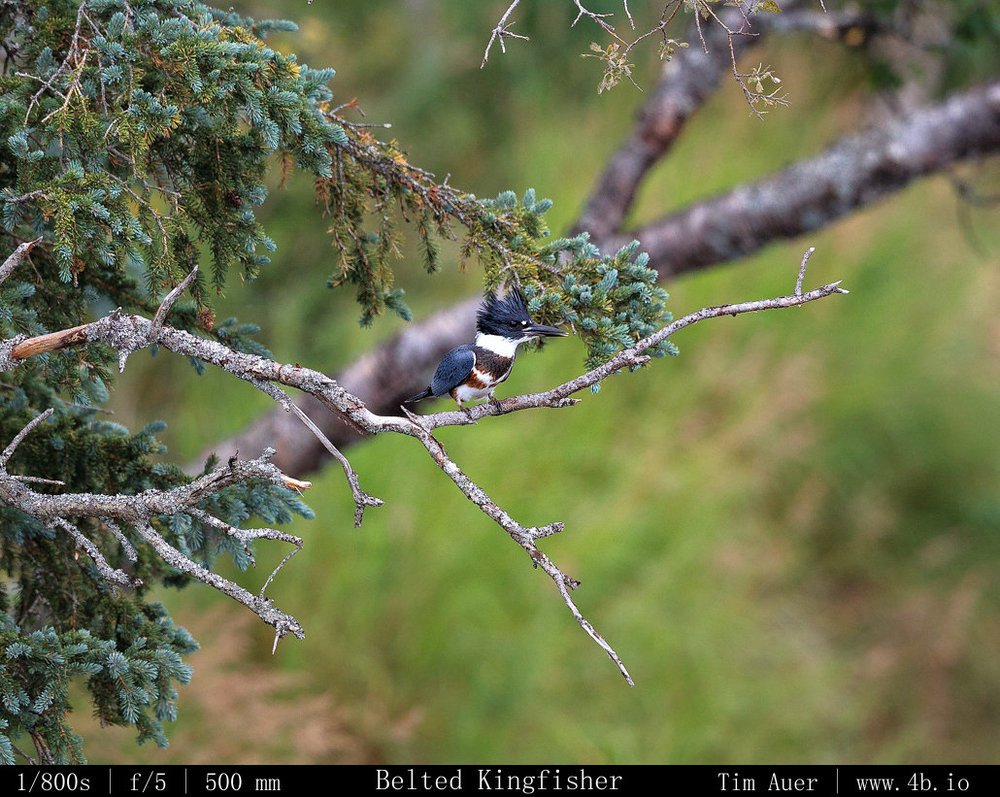
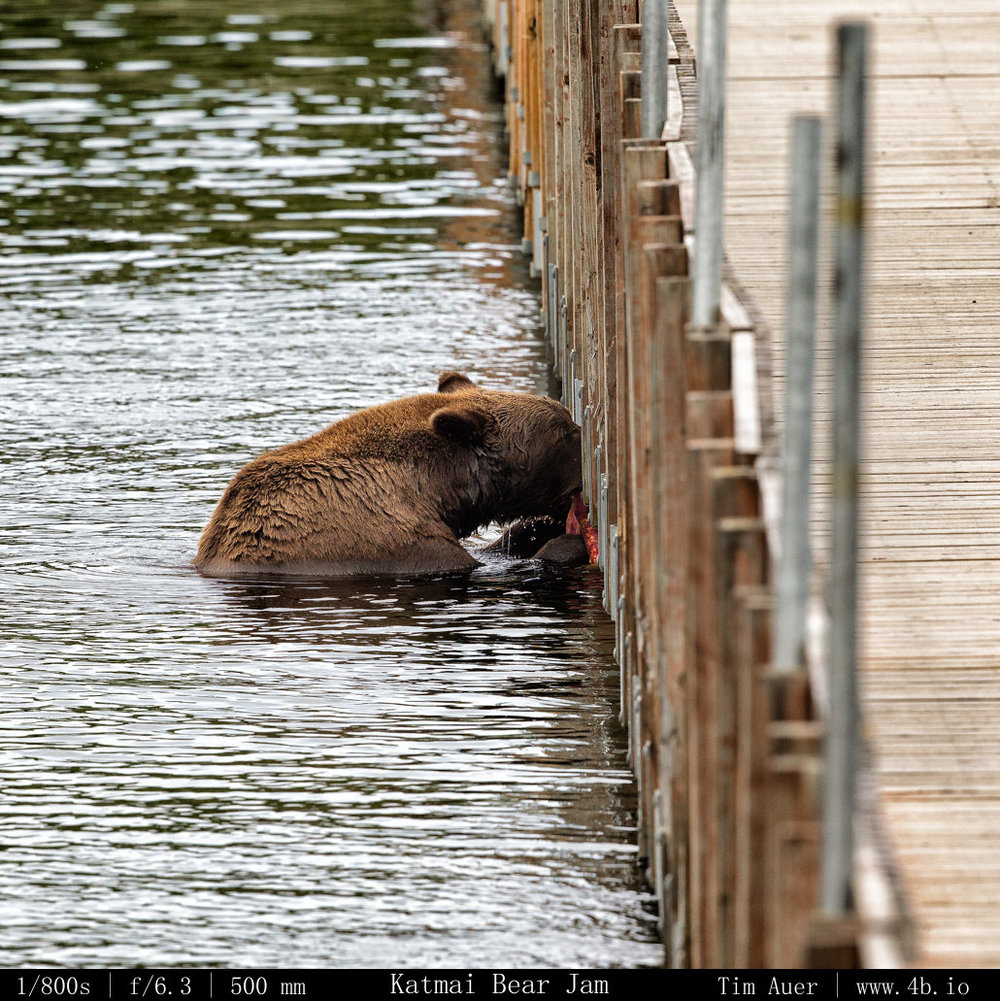











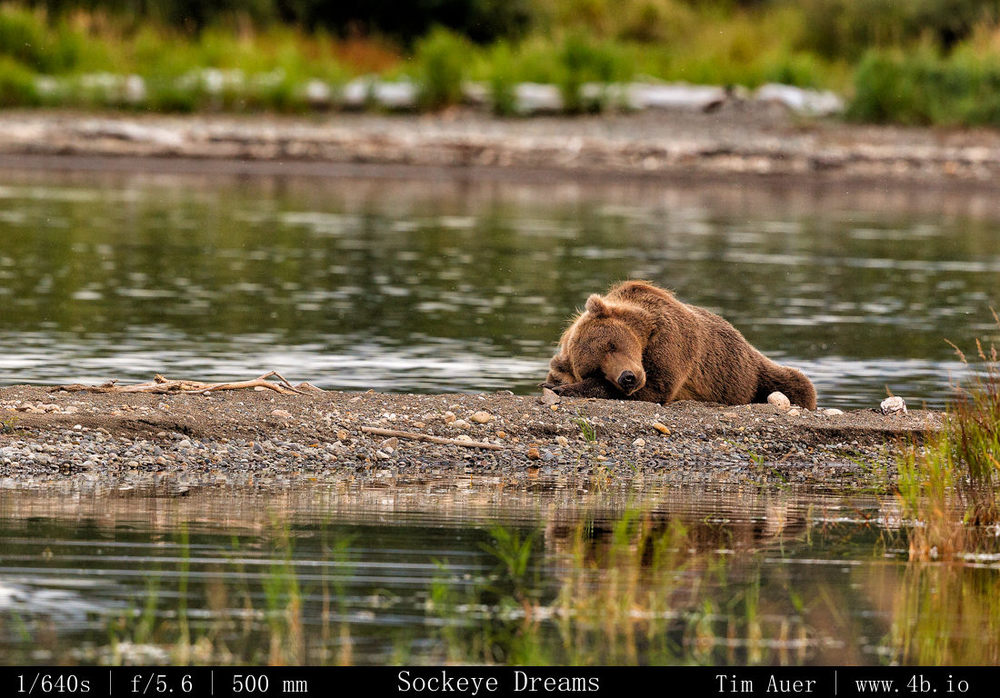





**This is a large GIF file and the download may take some time.
Taken from the description of day one in Katmai .
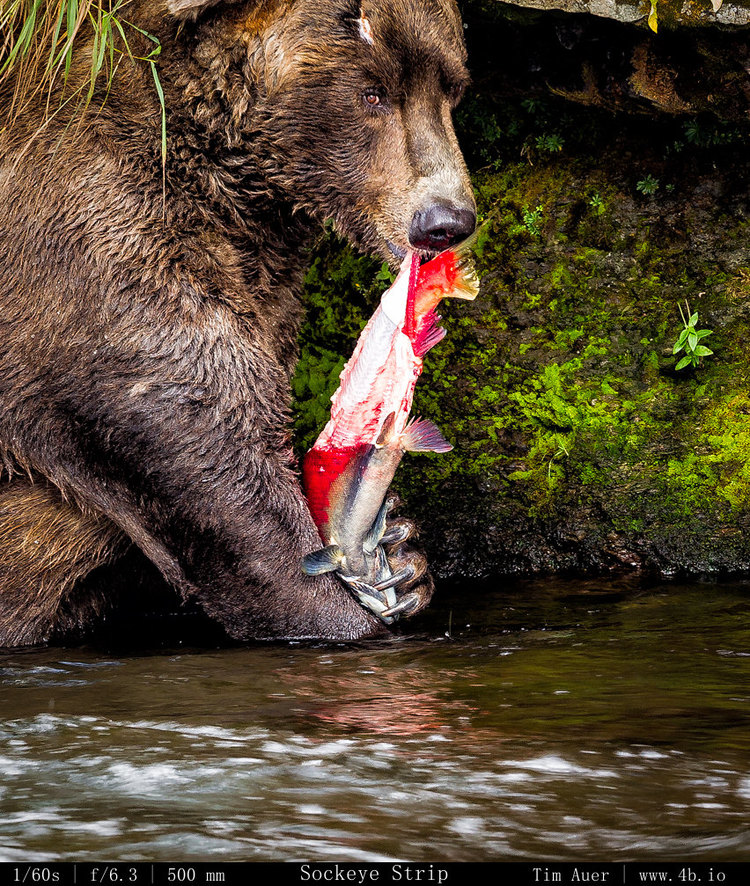
Here is an animation showing Otis eating a salmon in the far pool of Brooks Falls in Katmai National Park. Notice how he braces the fish on his shin. If the Sockeye could speak it would probably scream, “WHY ARE YOU STARTING AT THE TAIL? BITE ME IN THE HEAD!“.
This GIF animation is comprised of 120 exposures taken in multiple bursts over a 3 minute span. I processed each .CR2 raw file in Lightroom, cropped it, and aligned each exposure to minimize flicker. Then I exported the full batch to low quality JPEG, and sent it over to Photoshop CS6, for GIF creation. When I shot this, it wasn’t my intent to create an animation (although I always keep it as a possibility in the back of my mind…). Towards the end of the fish, the sun began to peak through the clouds and brighten up the scene, which changed the light. You can even notice in the image footer when I adjusted aperture to compensate for the varying light conditions.
Here are a couple higher resolution “still” frames from the animation:

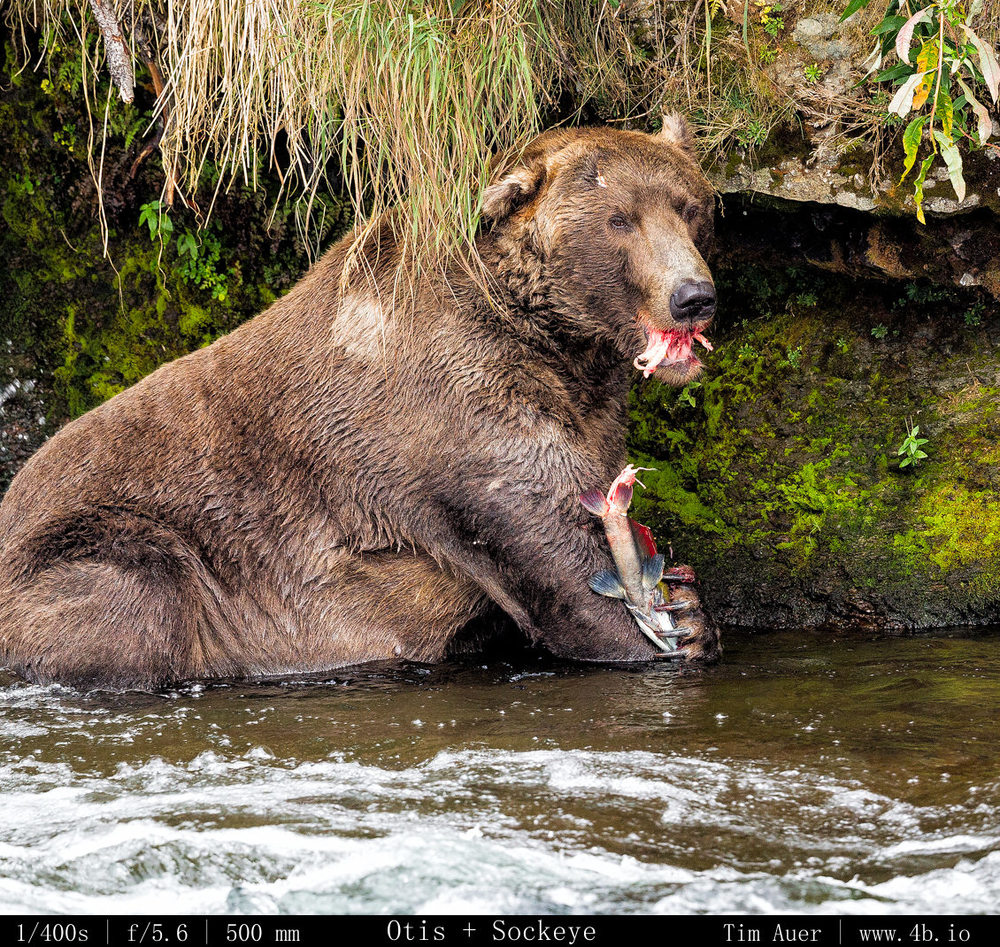

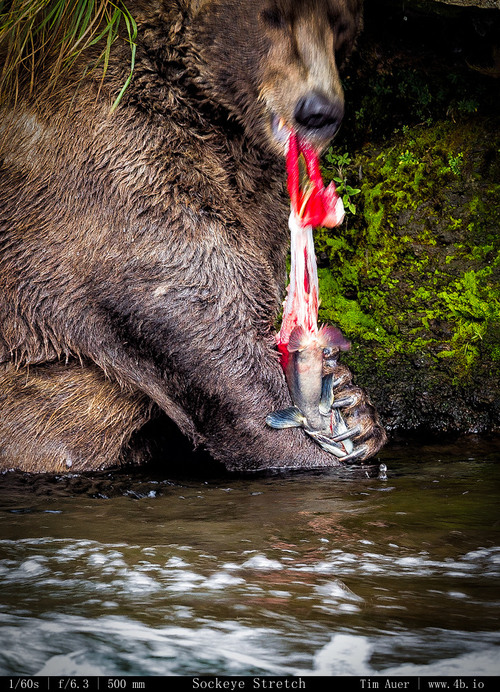
What makes wildlife interesting? For me, there are a couple characteristics that distinguish specific species from others and make them more appealing to me to observe in their natural habitat.
In Guns, Germs, and Steel, Jared Diamond speculates that all species of domesticated animal share six proposed characteristics. The combination of all six characteristics indicates that the species lends itself to being domesticated. If a species lacks one of these characteristics, it has the same likelihood as being domesticated as a species with none of the requirements. Anna Karenina.
Maybe you can see where this is heading. If you were expecting something profound, I suspect you will be disappointed. I have obviously tailored this list to a brown bear.
A species must have the following characteristics to be considered “interesting”, at least until my bear obsession passes.
With that established, lets go a bit deeper. Given these characteristics, it is never wise to set expectations unreasonably high before venturing on a wildlife trip. If your hopes are set too high, you will often find yourself disappointed by what is perceived as a poor showing….this leads into my next post about Katmai National Park..
SF to Anchorage flight was this evening, now I am in hotel in midtown Anchorage, preparing for my great bear adventure. Tomorrow I fly on two more planes: Anchorage -> King Salmon, and King Salmon -> Brooks Camp (float plane) to reach Katmai National Park out on the Alaskan Peninsula. All in pursuit of the massive coastal brown bears that live there… I will camp in the NPS campground there and maximize my time seeking out the bears.
I have cleaned my sensors and lenses, formatted 400GB worth of memory cards, charged 11 camera batteries, and re-activated 5 Pelican desiccants (this Peninsula is wet). Lets puts this 500mm to work.
Check out the following link from time to time, you will see some bears, maybe you will see me. This camera pans quite a lot, but there is a gated bridge that I will be crossing when it opens each day at 07:00 Alaska time.
http://explore.org/#!/live-cams/player/brown-bear-salmon-cam-lower-river


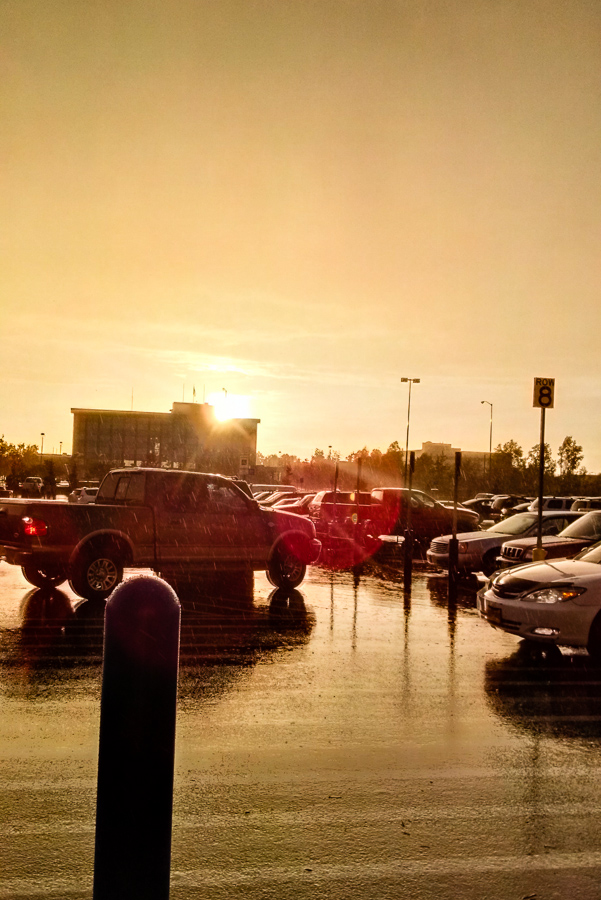
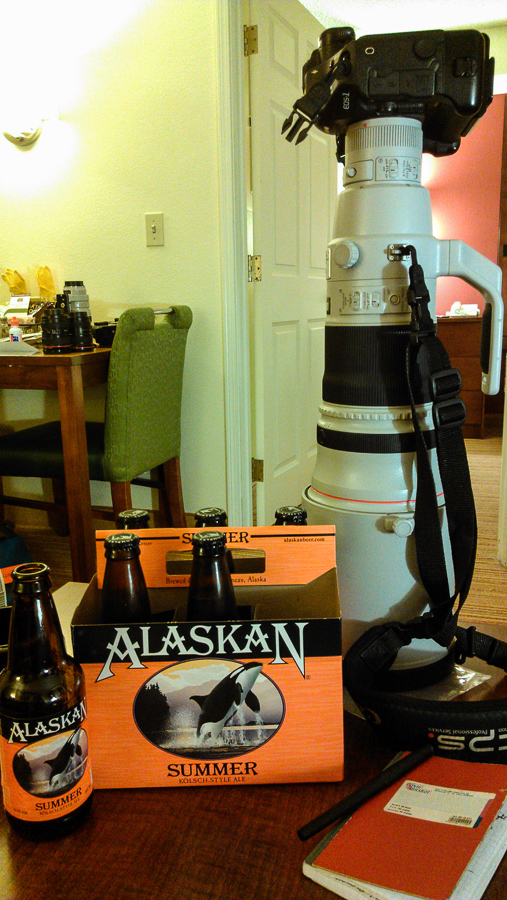
In preparation for my trip to Katmai National Park this week. Here is a small gallery of photos taken on a single day from last years trip to Glacier National Park (Sept 2012). These were taken in the Many Glacier section of the park. It was crawling with bears, both grizzlies and black bears. I was shooting with Jeff Callihan. We made sure to stay upwind from where we assumed the bears were located, thereby alerting them of our presence by scent. We saw several grizzlies, including a mother and her cub.

One of the grizzlies got a bit too close for comfort, as seen in this gallery. We handled this bear calmly, carefully and respectfully. The bear had been popping in and out of the thicket for several hours, never coming within 200m of our position. We remained stationary the entire time. After sometime, the bear began to appear closer to our position. When she emerged from the thicket about 40m away, we stood up and slowly moved, side by side, away from the thicket and into the meadow to give her right of way should she desire it. Looking at us, she kept coming towards us. When she charged in our direction, we spoke firmly to her, reassuring her of our implicit human-ness. The charge was likely a curious, exploratory one. But one can never be complacent with a charging grizzly, and the simple act of showing our backs could have triggered the predator/prey instincts of this apex predator.

At the nearest, she was within 20-30 feet of us. Once the situation was defused (without needing to spray the bear), Jeff and I quickly left the area and returned to his truck with a freshly invigorated respect for these powerful animals.
The Grizzly bear is a subspecies of the Brown Bear. To be clear, a grizzly (Ursus arctos horribilis) is an interior North American Brown Bear and was so named by the “grizzled” (read: silver tipped) appearance of its coat, which can be observed in these photos. This subspecies is different from its larger and less “grizzled” cousins found in the coastal regions of Alaska, including Kodiak Island and Katmai NP, and other brown bear subspecies (Russia, Europe). Despite this, and this is where the confusion stems, the eponymous term Grizzly Bear has been applied to both the inland and coastal varieties of the brown bear. This is because the name “Grizzly Bear” is so awesome that the people near other brown bears got jealous and wanted a name more inventive than “brown bear”. While it is true that a proper inland grizzly bear is pretty awesome, other brown bears are awesome too, so they shouldn’t feel jealous of their smaller, meaner kin. The interior grizzly bears can be found in places like: Yellowstone NP in Wyoming, Glacier NP in Montana, Idaho, Washington, the parks of the Canadian Rockies, and inland Alaska (such as Denali NP). There is also an indie band named “Grizzly Bear”, but don’t let their lame and wanna-be obscure musical styling confuse you with the ferocious nature of this animal. Unless they took inspiration from a grizzly bear’s hibernation period, it would have been more appropriate for them to call themselves “Prairie Dog”.

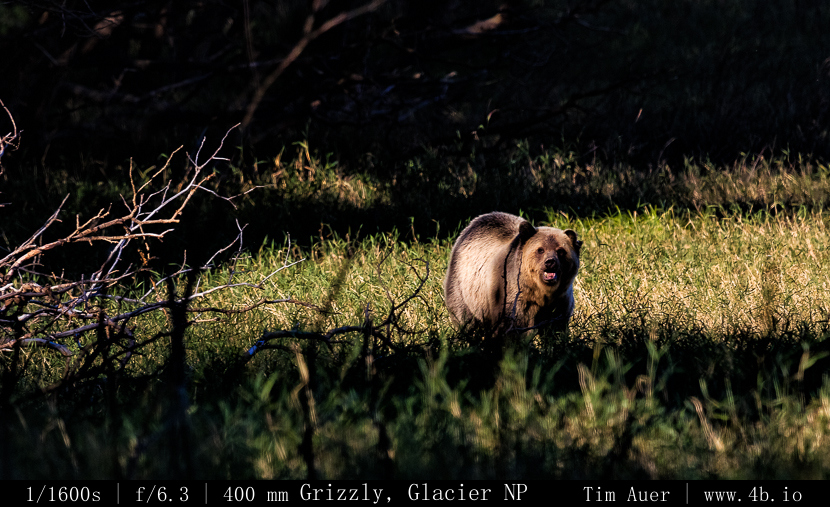





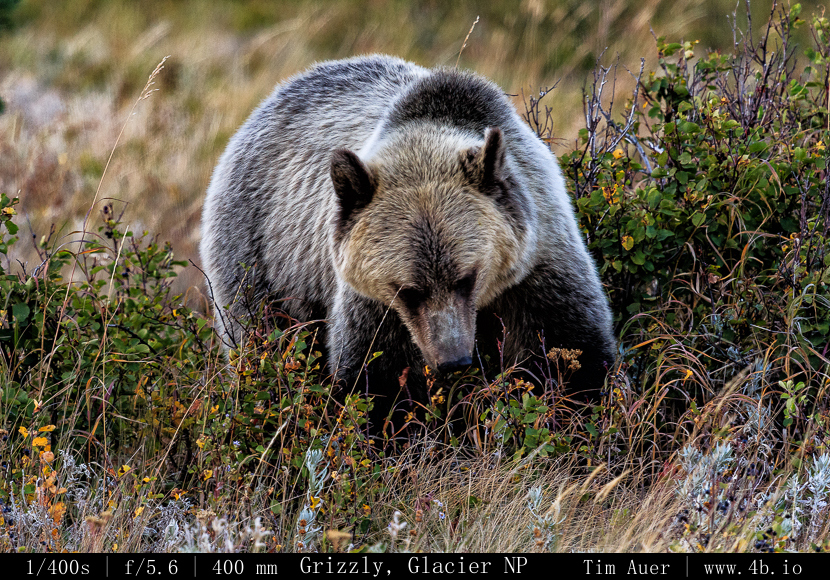

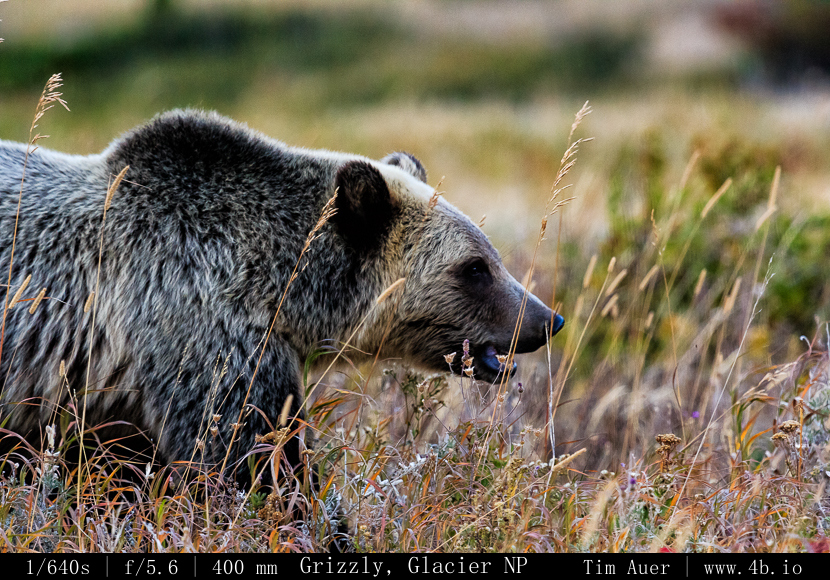
August 9 – 11, 2013
*Gallery at bottom*
Another August, another Perseid Meteor Shower….the 2013 edition. Not including the weeks of research and my previous scouting trips, I began my search for the Perseids late Friday evening for what was an astonishingly grueling three night photo epic to the dark skies of the Eastern Sierras…
 Golden red morning light
Golden red morning light
Leaving my house in Mountain View at 21:00 on Friday evening Aug 9, I began my drive East. As Friday blended into Saturday, I reached the Big Oak Flat entrance of Yosemite National Park. According to the weather board at the entrance gate, the daytime temperature for the high country of Tuolumne Meadows that day was 90F. I continued on Rt. 120 through the park towards Tioga Pass. At 01:00, made a brief stop at Olmsted Point, where there was access to a vast and clear sky. I snapped a few photos in the direction of Tenaya Lake, and caught glimpses of my first Perseids of the season. High up in the Sierras, the temperature had plummeted from its daytime high of 90F, and hoovered at the 28F mark (according to my car thermometer). After making my way over Tioga Pass and through the East Entrance of YNP, I began my descent towards Mono Lake. The temperature warmed gradually as I lost elevation. Arriving at the South Tufa Area at 02:30 Saturday morning.
There was only one other car in the parking lot. The car belonged to another photographer who happened to be wrapping up his session for night. While I thought him nuts to be leaving as the meteor activity began to peak, I had the entire Lake to myself. I was feeling relaxed and excited. Bats whizzed around my head, owls hooted, coyotes howled. I was even able to see an Owl silently flying 10-20 ft above my head. I was startled by its “shadow” and pointed my Surefire light at the shape, and watched it as it passed by. I’m sure the Surefire did wonders on the owl’s night vision too. Using only a casual, single camera set-up, I shot until approximately 05:30 before calling it a night. As I was getting myself situated for sleep in back of my wagon, Three cars arrived carrying a group of photographers looking to shoot the sunrise. They were in luck because the sunrise that morning turned out to be spectacular. I yearned to capture it, but refrained from doing so. This trip was about the meteors, so I soaked it in without the burden of camera apparati.
 Minarets
Minarets
By 07:30 I was up and eating breakfast at Nicely’s in Lee Vining. I continued south down Rt. 395 towards Bishop, stopping at Mammoth Lakes and the Minarets. Once in Bishop, I stopped in Galen Rowell’s Mountain Light studio and perused his work, seeking inspiration from a master. While there I bought two books, one a collection of technical essays he’d written and the other his best of Sierra Nevada images. I arrived in Lone Pine by early afternoon, bought some food, water, and beer, and set forth into the Alabama Hills….
I explored the Alabama Hills by driving along Movie Road and some its derivative “roads”, doing short over-land hikes to the various arches and interesting granite formations. Treating my extremely low clearance vehicle like it was a Jeep, I was fortunate that I didn’t become stuck or break an axle. While I was exploring new areas of the Alabama Hills, I was also scouting suitable locations to set up camp and shoot the Perseids. While hiking I came across a 5 foot long Gopher Snake, which, upon noticing me, curled into a mock Rattlesnake position, imitating its venomous cousin by vibrating its rattle-less tail in a fascinating sign of defense. Naturally, I got as close as possible and took photos of it.
 Imitation Rattler
Imitation Rattler 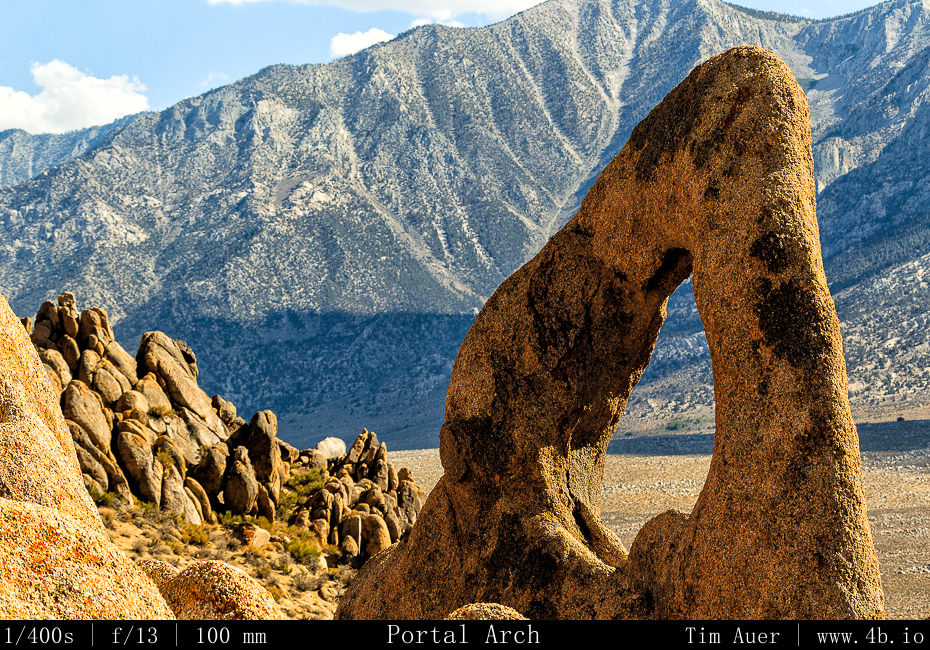 Alabama Hills + Sierras
Alabama Hills + Sierras
After searching long and hard for 6 hours, I finally settled on a location that satisfied my requirements. I wanted maximal Northeastern sky exposure and a rock formation that reached into the sky to create an interesting foreground. By the time I found a qualifying location, it was two hours away from sunset. Using the remaining daylight, I set up camp and composed my shots for the night. Tonight would be a 3-rig set-up. During this time before sunset, the temperature was warm, mid-80s, and very windy. Which made it difficult to set-up my tent and change lenses without dust. Fortunately the wind died down as the sun dipped behind the Sierras to the west. I climbed high up on several boulders and literally “bouldered” to get in position. From this vantage point I positioned my 6D+14mm F/2.8 (rental) and 1D Mk.iv+17-40mm F/2.8 angled up towards the Northern sky. These cameras, with granite spires in the foreground would use high ISO and shorter shutter speeds to permit the sharp capture of the celestial bodies. The FF 6D + 14mm prime would allow for longer exposures, while the 1.3x APS-H 1D Mark IV + 17mm zoom would have to be shorter. On the 6D I used a 38s exposure time and on the 1D I used 23s.
At a lower spot and on a smaller boulder, closer to my tent, I positioned my 60D+10-22mm F/3.5 with a minimal horizon and a vast north eastern sky exposure in frame. This camera covered the path that Perseus would race across the sky that night. The 1.6 crop body APS-C 60D + 10mm zoom is wide enough to allow longer exposures, but I used this one to do 10 minute exposures for star trails. My hope was by leaving the shutter open 10 minutes, there would less down time and capture more meteors, at the expense of not being sensitive enough to catch the fainter ones.
 How to prepare for a photo shoot
How to prepare for a photo shoot
I configured each cameras’ intervalometer, and hit go, hoping I’d be able to sit back and enjoy the show with a beer. As I should of expected, that was not the case and I barely finished the beer I drank with my Boudin bread and beef jerky dinner. I stayed alert and was constantly shifting the entire night. Spending the next 10 hours tending each camera and finding different positions to light paint the foreground granite. Wary of rattlesnakes and falling off (or in-between) house sized boulders, I put on a pair of jeans and resolved to never take a step without putting a light there first, and to always follow the same route used to climb up, on my way down. There would be no trail blazing in the darkness. By 05:00, I was exhausted, but satisfied with the meteor activity, I went to my tent and took a nap until the sun rose above the Inyo Mountains and shone into my face at about 07:00.
The highlight of the night: capturing the single brightest meteor. A massive green fireball that seemed to burn itself through separate stages, like a Saturn V rocket, as it skipped across the atmosphere. Not only was I able to capture it with one camera – I had the good fortune to record this event on all 3 cameras. Each one showing a slightly different perspective of the same meteor.
(For less confusing examination of the multiple perspectives, see the gallery below)
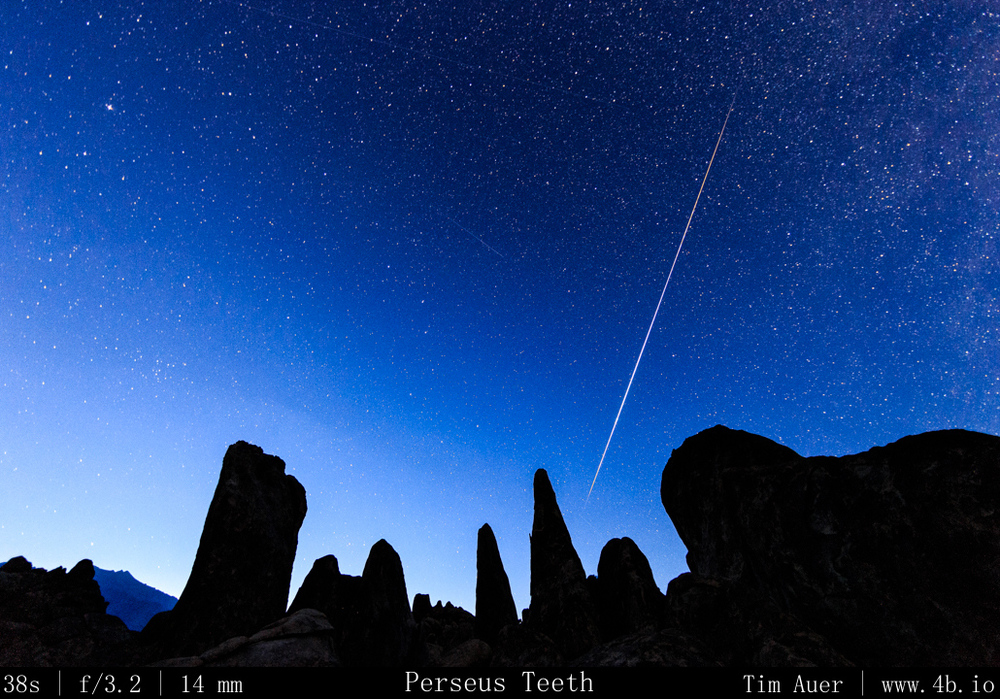


 The long and winding road..
The long and winding road..
After breaking camp, I drove back to Lone Pine and had breakfast at the Alabama Hills Cafe. Moving at a relaxed pace this Sunday morning, I stalled in the cafe to recharge my batteries for as long as I could. After spending some more time exploring Lone Pine and its surroundings, I gradually began to make my way up 395 to Big Pine, California (elevation 3,900 ft). I topped off my gas tank, turned right at the edge of town on to California Rt.168 (10 miles), then a left onto the very steep White Mountain Road. After 13 miles of steady ascent, I was in the windswept lands of the ancient Bristlecone forests. To be exact, I was at the more accessible Schullman Grove (elevation 10,100 ft). This is where the paved road ended, and the halfway point to my destination. Ascending even higher for 12 additional miles on very rough dirt road (it took 90 minutes), I finally reach my destination: The Patriarch Grove. Nestled high in the White Mountains at an elevation well over 11,000 feet, the harsh landscape here looks more suited to be the moon than any place on green, hospitable earth. Yet, the dusty mountain sides are teeming with life, in the form of the magnificent Bristlecone pine. Gnarled, beaten down, and broken, these trees thrive here in these conditions. Some have held on to life for more than 4000 years. With so many unworldly features, this is the perfect place to connect the life on Earth to the rest of the nonliving universe. It was exhilarating to have the privilege to photograph the starlit heavens raining with meteors here.
 Bristlecones, with their bristles
Bristlecones, with their bristles
After parking, I took a short hike through the grove in the warm afternoon sun, scouting my nighttime locations. As I did so, a few people showed up and began to assemble telescopes and scout their positions. By sundown, the people in the grove filtered down to those of us staying through the night, about 5 or 6 people in total. After spending the last two nights completely alone and isolated, it was nice to be able to talk with some other people, and hear their experiences. Like the previous, this night was to be a 3-camera show too. I decided to take a slightly different approach this evening. The two ultra wide set-ups would sit stationary for hours, while the other camera would be my “roamer”.
I positioned the 6D+14mm in a northeasterly direction and the 60D+10mm in a westerly direction. The 60D was positioned west because I particularly liked the composition, and no other reason. Besides, I felt like on the previous night there more hot fireballs in that piece of sky. So I knew the Perseids would be everywhere. The 1D+17mm was my roaming unit. I would find a position for this camera, compose the shot, and let it sit for 15-90 minutes, depending on the conditions. At one point, this camera was on top of a peak over a half mile away from my two other cameras, which were in the same general area and only 200m apart. For this night, I decided to use slightly shorter shutter speeds, while pushing the ISO with the goal of capturing even the most faint meteoric activity. There was no time to rest for the next 7 or 8 hours, and when I did take a break to watch the sky, I realized the temperature had dropped well below freezing. My Nalgene had even begun to freeze! By 04:30, I was getting quite chilled, I decided to warm up in my car and to take a brief nap, knowing that I would need to wake by 05:30 to reconfigure my cameras and avoid overexposing the frames in the morning twilight.
Despite having a 30 degree bag, being fully dressed, and inside my car, I never was exactly comfortably warm. It must have been colder than I realized, but I shouldn’t be surprised of this considering I was at elevation over 11,000 feet. Bleary eyed and mouth parched, I roused myself at 05:30. It was still quite cold and dark and conditions like that always demand some additional effort to overcome, but I can proudly say I was up and out in less than a minute! I even have to photographs to prove it. One of my cameras looked the direction of the car. To the naked eye, it was still very much dark out, but to a camera’s ISO 6400 sensor, it was rapidly beginning to overexpose. As the sun approached the horizon, I needed to adjust each camera 4 additional times to accommodate the varying conditions.
 Self “portrait”, morning light
Self “portrait”, morning light
The quality of light at sunrise here in the White Mountains was superior. It was a rich, golden red light that rapidly raced along the mountain side, reflecting off the white dolomite, but it didn’t last long. As the sun crept higher above the horizon, this golden red light became orange, then yellow, and then a flat white…
Thus signalling the end of my Perseid weekend…and the start of my 8 hour drive back to Silicon Valley for work.
New gear utilized:
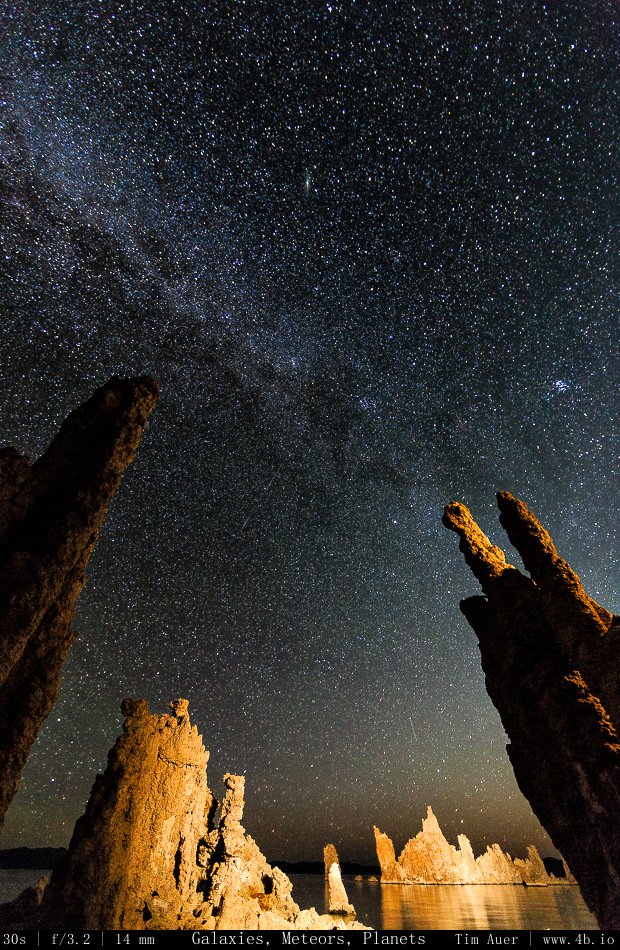




















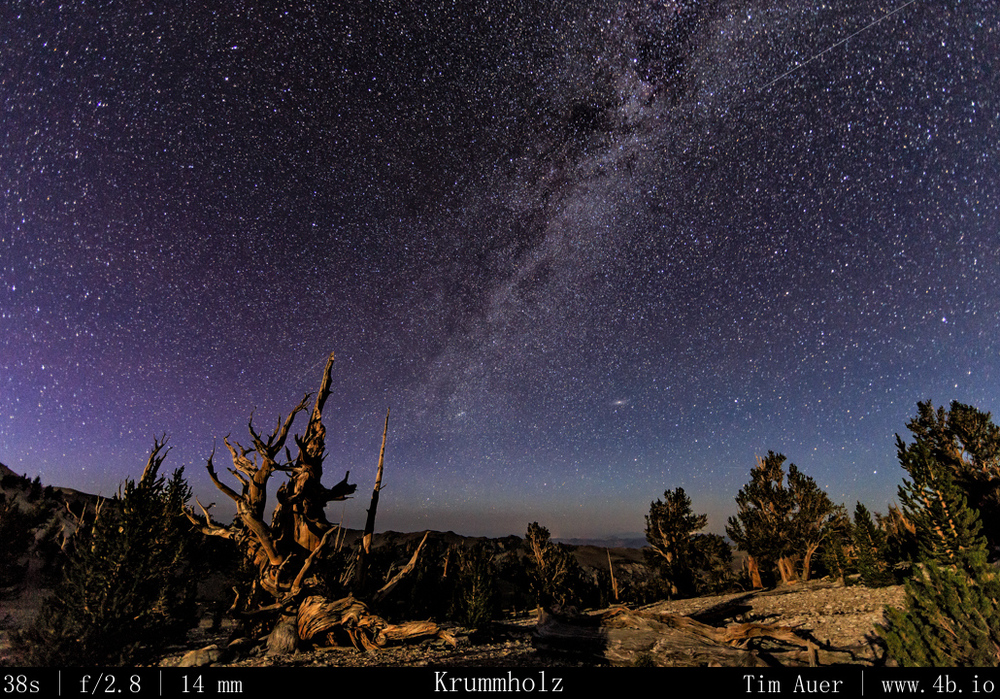

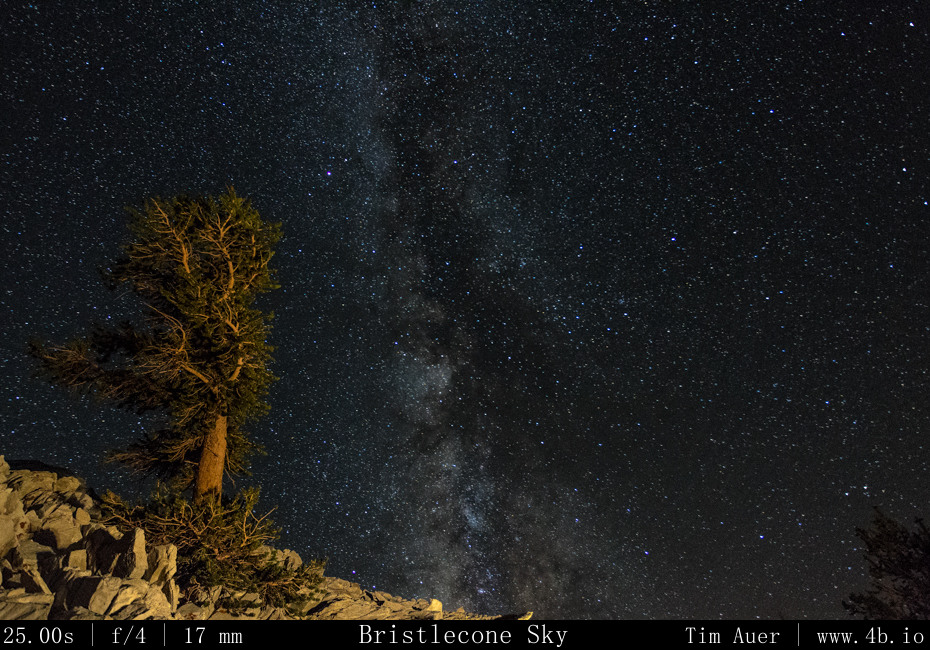

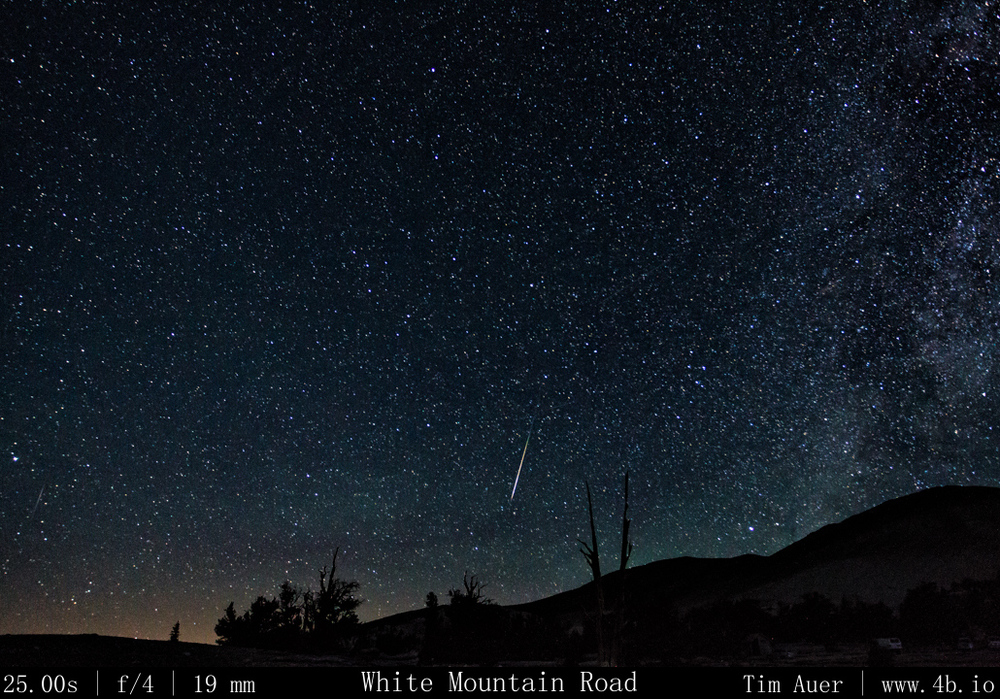


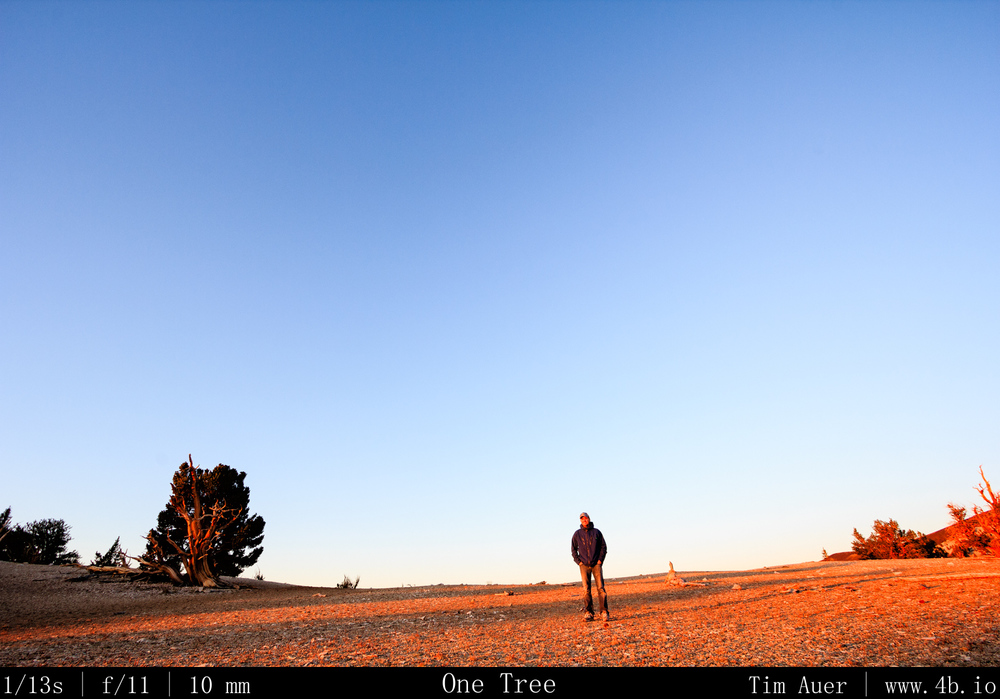
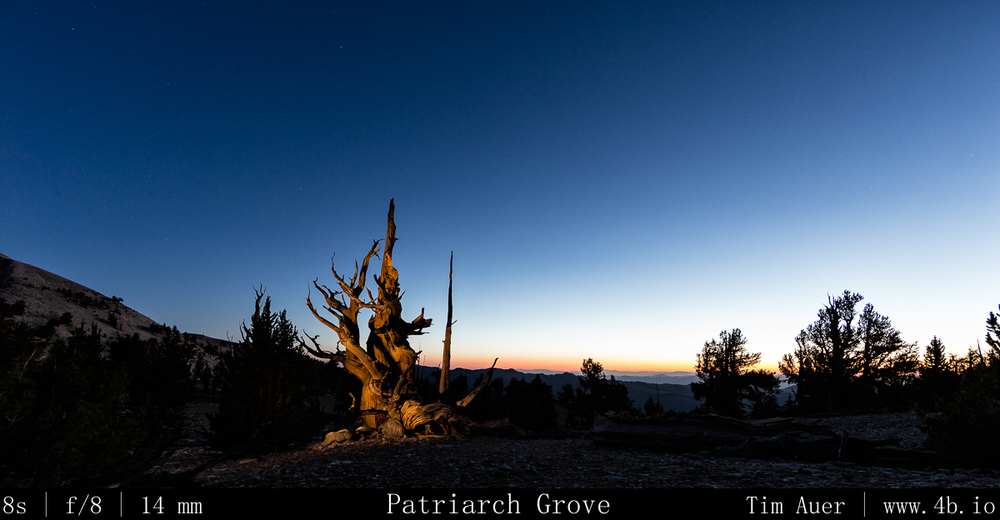



Locations: Mono Lake, Alabama Hills, Patriarch Grove Bristlecone Pine.
Here are a couple of images I took over the weekend. Now I must go to bed because I haven’t slept more than an hour or two since Thursday…




In the heart of the Volcanic Tablelands near Bishop, California are the Red Mountain Fish Slough Petroglyphs, and it is probably one of the more fascinating places I have ever been.

The Owens Valley was part of a trade route for the Paiute Indians, connecting what is now Northern California and the American Southwest. This area has been inhabited by the ancestors of modern Paiute for almost 9,000 years and the Fish Slough area rock carvings date back 5000 years. In my effort to understand the significance of this site, I thought it best to relate it to my European influenced perspective. I likened the Red Mountain rock formation having a role similar for the Paiutes as a temple or cathedral did for early Europeans. I can’t help but be amazed at the setting of such a place like Red Mountain. And it was this that made me draw parallels between it and the famous religious sites and cathedrals in Europe. This place is different on one level though. It seems that many of the ancient locations of the Abrahamic religions have been lost, developed over, or redeveloped. Disrupting the string of time. Diminishing its unadulterated age. Red Mountain is unchanged. It is fascinating to think about how long people have worshiped at this single location, and that the landscape appears today much like it did when the first humans walked past this outcropping of stone 9,000 years ago. Aside for the occasional farm truck stirring up dust or airplane overhead, there is hardly any evidence of the modern world here. This place has remained largely unchanged for thousands of years, with new petroglyphs being the only perceivable variation over the centuries. Thousands of years before any European cathedral was built, and even before the pyramids….the inhabitants of pre-historic America began carving art into this outcropping of granite and Bishop Tuff. As is often the case, the experience here transcends what is captured in the photos. But to give a rough idea of how spectacular the setting of this place was, the following photo is the view I had during my visit. At my back is what was likely considered the main “altar”, and looking straight ahead were the dramatically lit White Mountains draped in a rainbow.

When I arrived at Red Mountain, I was completely alone. After about an hour to myself, a family of four drove up (husband, wife and son and daughter). The father was native American/Indian descent (Arizona), and he was very passionate about his opportunity to visit this site. During our conversation, he explained the cultural significance of the site, interpretations of many of the carvings, and also how this stone can be sold for a lot of money on the blackmarket in Europe. Really disgusting that people cut 5000 year old artifacts for this own selfish motivations. If you look closely at some of the photos attached, it is possible to see where people have vandalized the petroglyphs, by trying to “cut” them out for blackmarket purposes.
Specifically, in the image titled “Altar“, you can see some of the defaced stone. This “Altar”, mentioned above in the context of the rainbow view, was the centerpiece of the rock formation, and appeared to be positioned like an altar in the Christian church sense. This was where the shaman or priest would lead ceremonies. The carvings at the Altar is also one of the older carvings at this site and its design was particularly meaningful. The entire carving was completely connected. Let me explain: Most of the other figures at Red Mountain were discrete, individual carvings. These altar carvings were completely connected, top to bottom, left to right. This continuity was symbolic for the Indians who wanted to connect the ground to the heavens. Thereby, providing a channel for their spirits to flow, connecting them with their ancestors. This is also why the top and bottom of these carvings have points, or arrows, directed at the ground or up to the sky.
I learned all of this while talking to this guy. It was really nice that he was there to explain it to me. His son, probably a 5 year old, was finding rabbit bones and looking for rattlesnakes. His daughter, probably 8 years old, kept asking her dad if they could leave because the hotel swimming pool closed at 8PM. So if they left now, they could get an hour and half of swimming time.

Photography
Due to the high Sierras due west, the sun sets very fast at this location. There were a few minutes of quality, evening light able to bring out the brilliant red granite color, but before long the sun was behind the mountains. However, due East are the White Mountains, also 14,000 footers, and due to their height, they are able to hold on much longer to the sunlight. Once the Red Mountain was shroud in shadow of the Sierra Nevadas, I pointed my lenses in the eastern direction as the canyons between the White Mountains’ peaks transformed into vibrant red colors. The light here is only useful in photographic terms at sunrise and near sunset, and the lack of shade would let it get quite hot and miserable mid day in summer. This place is best visited when the light is gentle, and temperature pleasant enough to let you comfortably contemplate the rich human history of the site.
For more information: Visit the Bureau of Land Management Field Office in Bishop
http://www.blm.gov/ca/st/en/fo/bishop/archeology.html





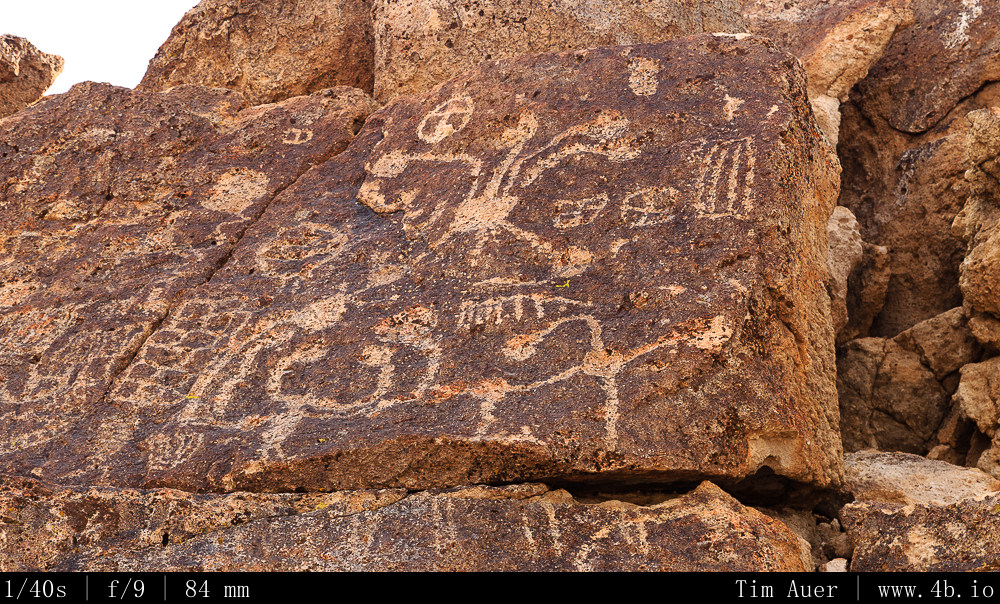




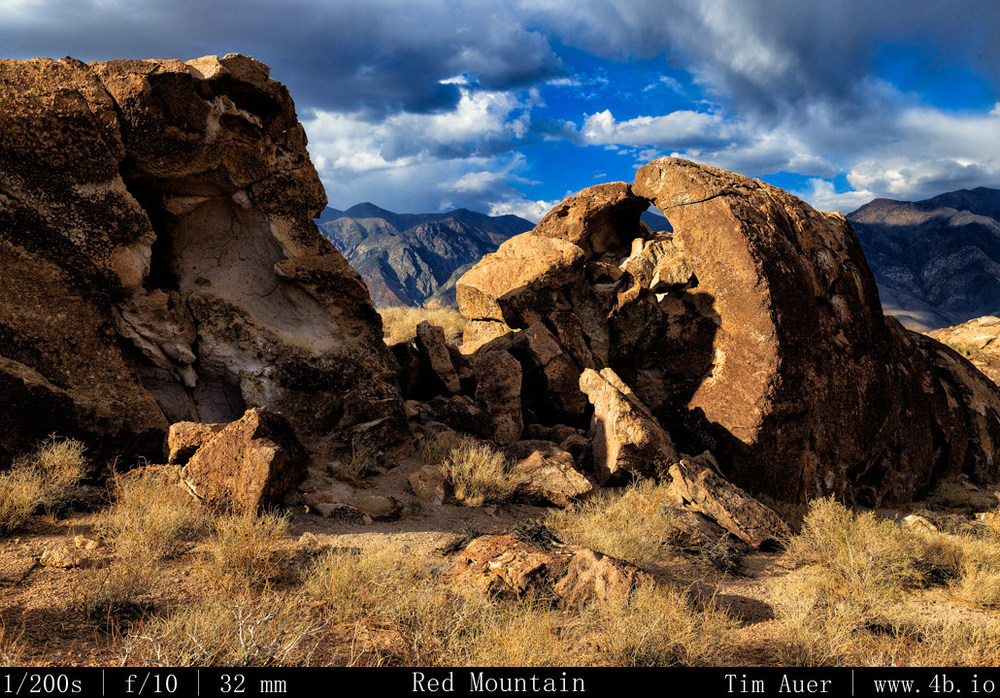

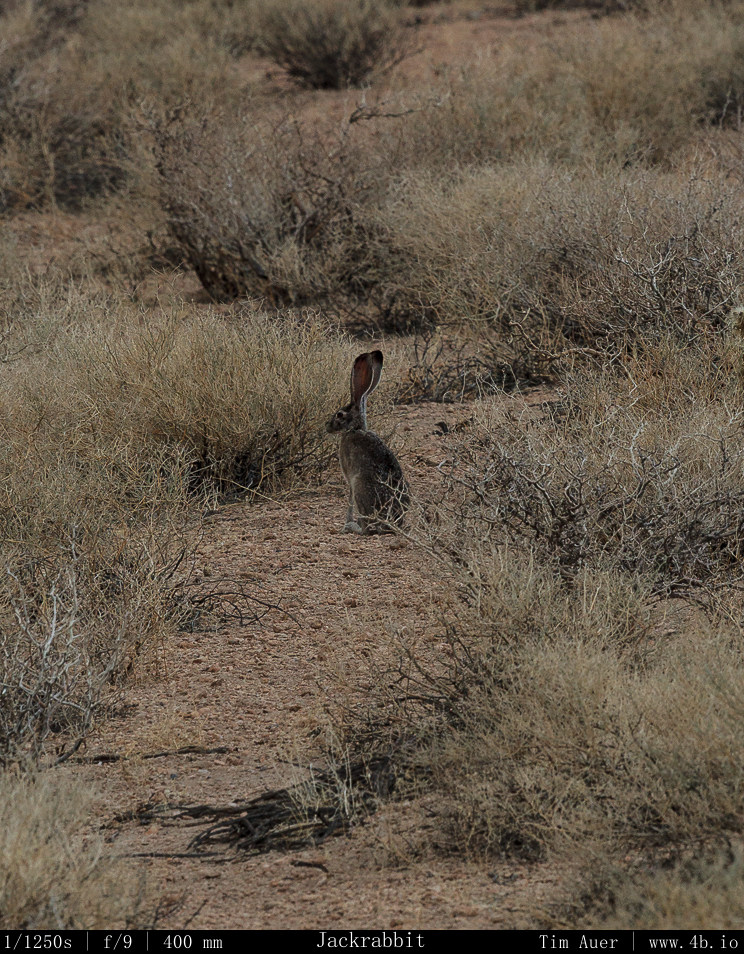





Ich bin geschäftlich in München….I am working in Munich for little bit, but will be back soon to finish my Eastern Sierra Report. Until then I am photographing the Bavarian Alps when I don’t have to work…
Garmisch-Partenkirchen, Chiemsee, Königssee, Berchtesgaden
View from the balcony in my room at Hotel Bavaria in Berchtesgaden. http://www.hotelbavaria.net/
